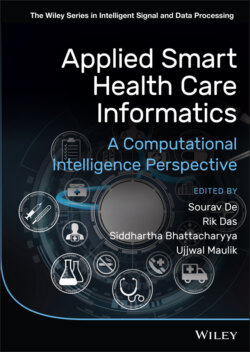Читать книгу Applied Smart Health Care Informatics - Группа авторов - Страница 15
1.2 Big Data Analytics in Healthcare
ОглавлениеBig data analytics can be applied in different areas of medicine. The concept of big data analytics can be employed in different areas and among them image processing, signal processing, and genomics (Ritter et al., 2011) are primarily noted.
Medical images are a vital source of data, and they are frequently employed for diagnosing, assessing therapy, and designing (Ritter et al., 2011) algorithms. X‐ray, magnetic resonance imaging (MRI), molecular imaging, computerized tomography (CT) images, photo acoustic imaging, ultrasound, fluoroscopy, and mammography are some instances of imaging methods that are found inside clinical settings (Belle et al., 2015). Medical images can run from a couple of megabytes to process a solitary report to many megabytes per analysis: for example, thin‐slice CT studies (Seibert, 2010). These types of information need huge capacity limits for long term data retention and require accurate and fast algorithms for decision‐assisting automation. Likewise, if other sources of information obtained for an individual patient are additionally applied at diagnoses, prognosis, and treatment, then the issue of proving reliable storage and increasingly advantageous methods for this large scope of records turns into a challenge.
Like health care images, medical signals likewise present quantity and speed snags, particularly during the persistent acquisition of high quality images and their storage from the many screens associated with every patient (Belle et al., 2015). Physiological signals not only create information dimension problems but also have baffling complexity of a spatiotemporal nature. Nowadays, numerous heterogeneous and uninterrupted monitoring devices are employed in the health care system to apply solitary physiological waveform information or crucial discrete data provided to systems if there should be an occurrence of plain occasion (Cvach, 2012; Drew et al., 2014).
The human genome is comprised of about thirty thousand genes. It has been observed that the price to sequence the human genome decreases with the advancement of high‐throughput sequencing technology (E.S. Lander and et al., 2001; Drmanac et al., 2010). Investigating genome‐scale information with suggestions for current public fitness insurance policies, the conveyance of care, and creating noteworthy proposals in an opportune way is a sizeable undertaking to the discipline of computational biology (Caulfield et al., 2013; Dewey et al., 2014). In a clinical setting, the delivery of these recommendations are very costly as time is very crucial.
In spite of huge expenditures by the current health care systems, clinical results become minimal (Oyelade et al., 2015). For big data analytics, it is a hazard to expect an extra quintessential section to help with investigation and revelation measures, bettering the conveyance of care, helping with the plan and design of medical care strategy, and make use of a way to exhaustively assess the muddled and tangled medical services information. More specifically, appropriation of the bits of information received from big data analytics can possibly save lives, enhance care conveyance, prolong admittance to clinical services, regulate installment to execution, and assist managing the improvement of clinical offering costs (Belle et al., 2015).
